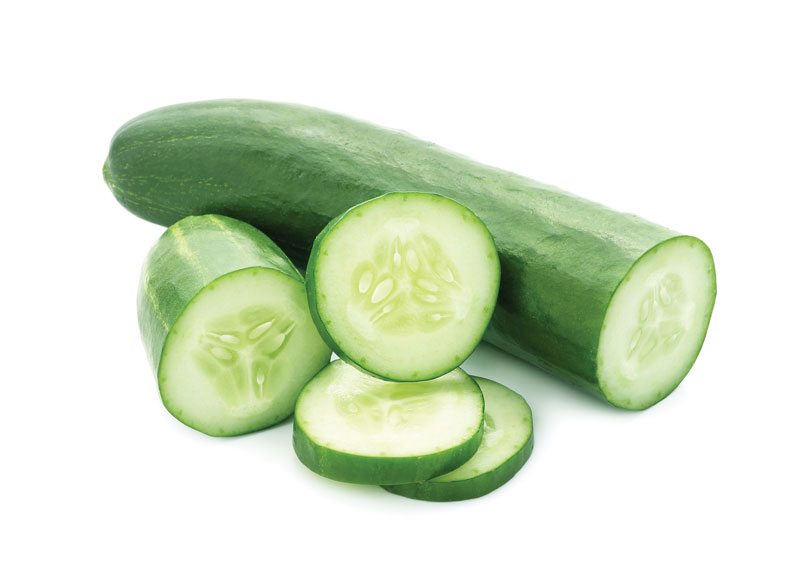It is always exciting when the cucumber harvest starts, but within a few weeks of the season we are often overrun with their abundance. My solution to this dilemma is to adopt the old motto, “variety is the spice of life”. Getting creative with the use of cucumbers keeps things fresh and interesting so that I can enjoy them throughout the entirety of the growing season.
There is something irresistible about the cool crunch of cucumber. Thus, it is not surprising that cucumbers can be found in most major international cuisines. They are related to other members of the Gourd family, including melons and squash. Because they are comprised of about 95% water, they are quite refreshing and filling, even though they contain very little calories and virtually no fat. However, they are also a very good source of vitamin C, Vitamin K, and potassium. They also contain significant amounts of magnesium. The skin provides added fiber.
There are two general types of cucumbers found in the U.S. They are referred to as “slicing” and “pickling” cucumbers. Slicing cucumbers are darker green, more uniform in color, and have a thicker skin. They are most often used raw, but sometimes also in cooked preparations. Pickling cucumbers tend to be smaller and more uniform in size and, when picked at the ideal immature stage, have a number of knobby “warts” on their surface. Pickling cucumbers are great for pickling, but their extra crunchy texture makes them a great addition to salads and other raw preparations.
Cucumbers are best known as a vegetable to be eaten raw in a crudité platter, salads, cold soup, sandwiches, or as a base for small hors d’oeuvres, a filling for sushi rolls, or as pickles. Because they are so neutral and absorb so much flavor they are great marinated with any kind of vinegar. They also offer a unique cooling effect when served with spicy foods, especially when mixed with yogurt or sour cream, as in Indian raita or Greek tzatziki.
While a less familiar preparation, cucumbers can also be cooked. Cucumbers sautéed for about 3 minutes in butter and a little water are delicious. One of my favorite ways to cook cucumbers is on the grill. Simply brush them with your favorite vinaigrette (I especially love it with miso) and grill at medium heat until softened.
Switching up texture is another way to keep the preparation of cucumber dishes fresh and lively. This is where my spiralizer comes in. Spiralizers can be found online or in many home stores. They slice a variety of vegetables into spiral shapes, leading to a noodle- like product. Simply substituting spiralized cucumber for sliced cucumbers in your favorite salad changes things up considerably due to the difference in texture. Note that spiralizing works best with firm, seedless cucumbers (like the English variety). Another method for changing up the texture is to cut long, thin strips of cucumber with a vegetable peeler. Similar to spiralized vegetables, this makes a noodle like product, which is great with vinaigrettes and cold sauces. Again, this works best with seedless cucumbers.
In my own garden, I am typically overrun with cucumbers and mint concurrently. I love to add a ton of mint sprigs and a bunch of sliced cucumbers to a pitcher of water, where it keeps in the fridge for 3-4 days and serves as a wonderfully hydrating and refreshing summer drink. To fancy it up a little, I substitute coconut water for regular water and add sliced lime—instant virgin mojito!
Below is a recipe I originally developed for my Holcomb Farm blog called “Simply Fresh”. It is a refreshing and hydrating drink that is perfect both for casual use and entertaining.
Cucumber Basil Agua Fresca
Yield: 2 quarts
INGREDIENTS:
- 3 large cucumbers, peeled and roughly chopped
- 1/4 cup fresh basil leaves, packed
- 2 quarts water
- 3 tablespoons honey or agave syrup, optional
Place cucumbers and basil in a blender and blend until completely smooth. Add a few tablespoons of water if needed, to facilitate blending. Over a pitcher or large bowl, pour cucumber mixture through fine sieve, using a wooden spoon to push and move around solids in order to extract liquid. Discard solids. To cucumber basil mixture, add 2 quarts of water. If desired, add agave syrup and stir.
Chill before serving.
Notes: For a refreshing but light cocktail, add 1 ounce white rum, dark rum, or gin to 8 ounces Cucumber Basil Aqua Fresca, then add ice. Add more agave syrup, if desired.
Julie Wern is a psychologist turned stay-at-home-mom turned caterer. She is currently in training at the Institute of Integrative Nutrition to become a nutrition and wellness coach. She is the author of Holcomb Farm CSA’s Simply Fresh blog and currently teaches cooking and cookie decorating classes. Contact Julie at jwern@comcast.net for comments and inquiries.
